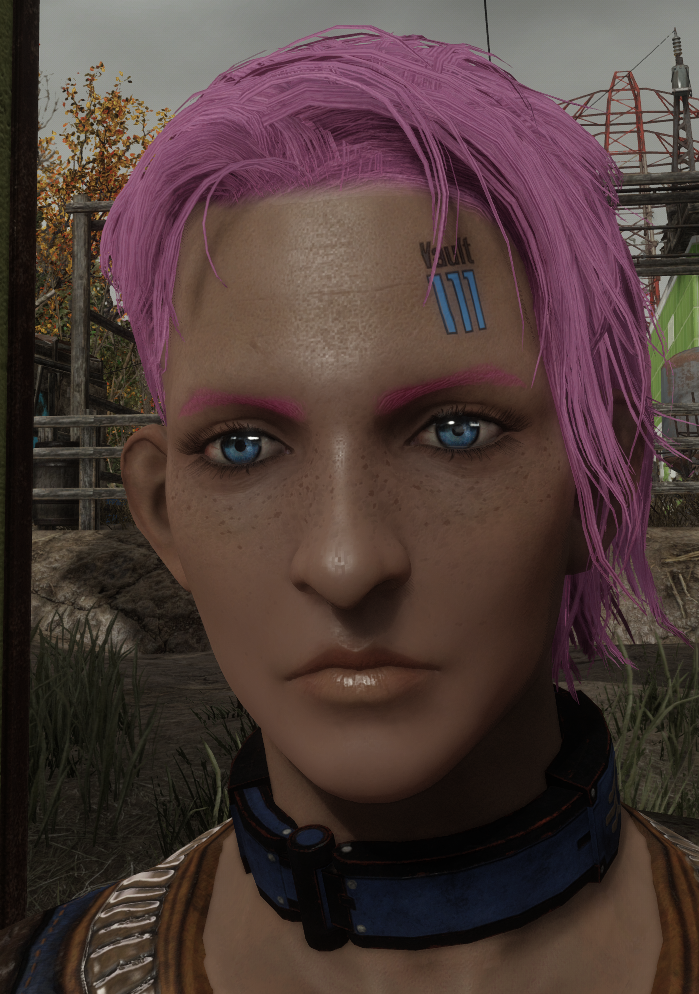Fallout 4 Data Reference: Charlotte "Charley" Ellison

Name: Charlotte Ellison
Aliases: Charley; The Sole Survivor
Date of Birth: August 3, 2052 (apparent age in 2288: mid 20s)
Hair color: Pink (pre-war: Blonde)
Eye color: Blue
Distinguishing marks: freckles, Vault 111 tattoo
Profession: Feudal warlord (pre-war: Lawyer)
Sexual preference: Preferred men pre-war. Charley has not had a satisfying heterosexual relationship since the death of her husband and circa 2288 her current partners are women.
Relationship status: Complex
Origins
Charlotte Ellison was an attorney in the Commonwealth of New England prior to the onset of the great war. As a resident of the upscale gated community Sanctuary Hills and the spouse of a veteran, she was offered a free membership in the local Vault-Tec shelter, Vault 111. This saved her life the day the bombs fell, but it was not the end of her difficulties. Vault 111 was an experimental site, and once she and the other residents were sealed inside, Vault-Tec performed a number of non-consensual medical experiments on them. In addition repeated courses of cryogenic suspension and revival, Ellison was subjected to chemical, pharmaceutical, and surgical alterations to her body and intensive psychological conditioning.
At some point prior to Ellison's revival, internal conflicts within the shelter's staff boiled over into open conflict. As of June 2288, the specific details of this event are unclear, but conversations with Alexia Gray revealed that at least some of the inmates escaped during this incident. Ellison remained in cryogenic suspension until October of 2287, when she awoke to find her husband Nate dead and her son Shaun missing. After escaping from the vault, Ellison made her way to Sanctuary Hills, hoping to reunite with her family. Instead, she met her family's domestic robot, who was still operational after more than two hundred years unattended. Codsworth explained to Ellison just how long she had been frozen and provided some extremely basic information about the state of the Commonwealth.
Ellison spent the rest of 2287 repairing the damaged buildings in Sanctuary Hills to the point where they could provide adequate shelter, though ultimately she had to retreat to the vault to winter over once the first snows rolled in. Over the course of this time, her efforts attracted several fellow settlers, including a family of refugees from Wolfburg to the west. Prior to their retreat into the vault, the group's salvage efforts had yielded a rare prize: a functional powered suit that allowed Ellison (and later her companion Winter Ainsleigh) to venture outside the vault even during the most bitter cold. Working in shifts, they continued repairing the homes that were at least somewhat intact and tore down the others for materials. At the same time, they ranged out into the surrounding territories, recruiting several more settlers with specialized skills.
Forging an Identity
By the time the settlers who were wintering over in the vault could emerge, Sanctuary Hills boasted a concrete security wall, a warehouse, and trading post. Ellison had already made some tentative contacts with other nearby settlements by this point, and with Sanctuary inhabited again she worked to expand this by establishing more permanent trading ties. This was also the time when Ellison's vision for her community started to evolve into its final shape. While the tenets of her philosophy would not be systemized and recorded in writing for several years, the critical elements took shape over the winter of 2287 and the spring of 2288.
Characterized by radical rejection of class- and gender-based divisions, Ellison ruled Sanctuary Hills in a way that would have been condemned as communistic by the people of her native time. In the lest bountiful times of the late 23rd century, however, the pooling of resources and planned division of labor helped Sanctuary compete with its larger and better-established neighbors, allowing the community to survive against the numerous threats that surrounded them. Somewhat controversial within her community, Ellison also insisted on the members adopting vault suits as their uniform. In the early days, many of the founding members of Sanctuary Hill customized their suits with additional articles of clothing or with modifications to he suits themselves, but Ellison gradually cajoled, convinced, and eventually demanded that the practice end. Furthermore, she insisted with fewer and fewer exceptions that outsiders who were not part of the community disrobe entirely within its walls.
While egalitarianism and communal sharing of tasks and resources are arguably the most important elements of Ellison's leadership philosophy, social nudity became the keystone that defined the state of law in her domains, and over the course of the spring of 2288 it was sensational stories about this aspect of Sanctuary Hills that spread throughout the Commonwealth, with most of the less exciting details lost in the retelling. When Sanctuary and several allied settlements ejected the raider gangs from Concord and established the city as Ellison's new capital, there was no debate about whether or not Sanctuary's laws would extend to Concord, and not long after it was Concord's law that served as the foundation for life throughout the entire region.
Drawing Lines
When Charlotte Ellison left Vault 111 in 2287, there were four recognized powers in the Boston area: Diamond City, Goodneighbor, Bunker Hill, and Vault 81. Of these, only Bunker Hill was situated on the outer bank of the Charles River, leaving Cambridge, Lexington, Natick, and Salem in the hands of unincorporated homesteaders, raiders, and mutants. The fifth power in the area, only acknowledged in whispers, was the Institute. At the time, the Institute's location was unknown but their central role in the creation of synthetic humans - Synths - was evident throughout the Commonwealth.
Ellison's capture and subsequent rebuilding of Concord initiated a series of events that shook the power structure in the Commonwealth. Despite initial hostility, Concord reached a state of detente with Vault 81, with the two Vault-Tec successors agreeing to divide the area into broad spheres of influence with the Charles as the dividing line. The subsequent arrival of the Brotherhood of Steel and their establishment of an armed enclave centered on Logan Airport remained an unresolved challenge in the summer of 2288, but a tense peace reigned between the three powers.
Diamond City and Goodneighbor, long in decline, found themselves increasingly forced to accommodate Vault 81's policies, while Bunker Hill continued to walk a careful independent path. By contrast, the Institute has been anything but accommodating or cautious. If anything, Institute activity became more aggressive and open over the first half of 2288; several attacks seemed specifically targeted at Ellison and her inner circle, and agents of Concord increasingly discovered signs of Synth activity. Concord's support for rebuilding the Minutemen, as well as its own standing army - the Concord Rangers - have given Ellison the tools to push back against Institute encroachment, but protecting the numerous settlements under her control remains a daunting task.
Kellogg's Ghost
The most overt of these early clashes with the Institute happened in May of 2288 as Concord and the Minutemen launched an effort to seize control of the land between Concord and Natick. Previously, this area had been inhabited by several raider gangs, including the large and well-organized Rust Devils. More recently, a new player had entered the scene: a large mercenary company based out of the ruins of Joint Base Hagen. Ellison had discovered that the leader of the mercenaries, Conrad Kellogg, had likely been involved with the killing of her husband and the kidnapping of her son, and she maneuvered her forces to encircle and reduce Fort Hagen.
Conrad Kellogg died in the fighting, but Ellison recovered a cerebral implant from his corpse that she suspected might contain clues about the fate of her son. After consulting with several scientists and investigating a number of leads, Ellison found herself with a name: Brian Virgil. Virgil was a particularly rare individual - an Institute scientist who had escaped from their hidden base and who might have the skills needed to access Kellogg's implant. The problem, of course, was finding Virgil. Undoubtedly, a man on the run from the Institute would go to great lengths to make himself hard to find.
At the start of July 2288, Ellison had settled on her next step: locating the shadowy group called the Railroad. If the rumors about this group were to be believed, they had helped many Synths escape from the Institute, and Ellison suspected they might have had a hand in Virgil's escape. But, just as the problem with Virgil was finding him, a similar problem existed for the Railroad. Other than a vague clue that suggested they might be based somewhere between Bunker Hill and downtown Boston along the old Freedom Trail tour route, she had little to work with. When Ellison started narrating Chapter 89 of her autobiography, she had just made the decision to seek out the Railroad, and that became the focus of the next arc of her story.
Edited by gregaaz



0 Comments
Recommended Comments
There are no comments to display.